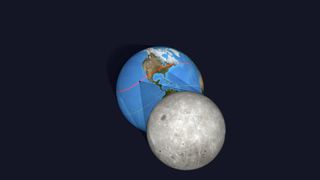
The moon’s shadow can only strike Earth when a new moon crosses the ecliptic at precisely the right time.
(Image credit: NASA’s Goddard Space Flight Center)
On Monday, March 25, the full “Worm Moon” will cause a penumbral lunar eclipse for the night side of Earth, including North and South America, Europe, East Asia, Australia and New Zealand.
The third full moon of 2024 and the first of spring in the northern hemisphere, the “Worm Moon” — also known as the “Crow Moon” and the “Lenten Moon” — will move through the Earth’s outer shadow in space.
As well as being an interesting astronomical event, it will set up a total solar eclipse exactly two weeks later that will be seen across North America.
We’re entering 2024’s first (and best) “eclipse season,” during which there will be two eclipses — one of the moon by the Earth and one of the sun by the moon.
A lunar eclipse occurs during a full moon — when the Earth is between the sun and moon, blocking sunlight from reaching the lunar surface. A solar eclipse occurs during a new moon — when the moon is between the Earth and the sun.
‘Eclipse seasons’ explained
A penumbral lunar eclipse on March 24/25 will put the moon on course to cause a total solar eclipse on April 8. This image shows a penumbral lunar eclipse from May 2023. (Image credit: Liu Debin/VCG via Getty Images)
Every 173 days, for between 31 and 37 days, the moon intersects (or almost intersects) the ecliptic—the apparent path of the sun through our daytime sky. The ecliptic is also the plane of Earth’s orbit of the sun. What results is a short season during which two — and occasionally three — solar and lunar eclipses can occur.
Eclipse seasons in 2024
In 2024, there will be two eclipse seasons each featuring two solar eclipses and two lunar eclipses:
Eclipse season 1
March 25: a penumbral lunar eclipse of the “Worm Moon” (North and South America, Europe, East Asia, Australia and New Zealand). April 8: a total solar eclipse (parts of Mexico, the U.S. and Canada).
Eclipse season 2
September 18: a partial lunar eclipse of the “Harvest Moon” (Europe, Asia, Africa, North America, South America, Pacific, Atlantic, Indian Ocean, Arctic, Antarctica.) October 2: an annular solar eclipse (Easter Island, Rapa Nui, Chile and Argentina).
Although there is no third eclipse in 2024’s second eclipse season, there so nearly is. According to timeanddate, an “almost lunar eclipse” will (won’t!) occur on October 17 when the full “Hunter’s Moon” just misses moving through Earth’s shadow. It’s a meaningless fact, visually, but it helps demonstrate how eclipse seasons work. It will miss because the moon will have been at its ascending node the day before, according to Astropixels.
The moon’s orbital nodes are why there isn’t a solar or lunar eclipse every month.
How the moon’s orbital nodes work
The moon’s shadow only hits the Earth when the line of nodes is pointed toward the sun. (Image credit: NASA’s Scientific Visualization Studio)
The moon’s orbit of Earth is tilted by 5 degrees with respect to the ecliptic. That guarantees that there usually isn’t a solar or lunar eclipse in any given month, but it also ensures that they must happen occasionally.
For one to occur, the moon must reach its new or full phase while it crosses the ecliptic. These two places are called the ascending node and the descending node.
The moon reaches those two nodes at different times every month. It usually does so when it’s not either new or full, so it isn’t in a position to eclipse or be eclipsed. Only during an eclipse season does the moon arrive at, or very close to, these nodes at the perfect time to cause an eclipse. The result is a short season during which two (and sometimes three) solar and lunar eclipses can occur, one after another, two weeks apart.
What causes partial and penumbral eclipses
Slight eclipses — a partial solar or lunar eclipse and a penumbral lunar eclipse — occur during eclipse season when the moon reaches a node just a few hours or a day too early or late. On these occasions, it misses its target, either eclipsing only part of the sun or moving through Earth’s outer shadow.
Either the new moon is slightly above or below the sun, and the full moon is above or below Earth’s shadow. Only when it reaches a node at precisely the right time does it cause a total solar eclipse or a total lunar eclipse.
That’s what makes Monday, April 8, such a special day for North America — and why you should, if possible, travel into the path of totality. Only then will you see, with your own naked eyes, the sun’s majestic, spiky white corona revealed in a dark sky.
Note: Only look at the partial phases of any solar eclipse with proper eye protection, which means solar eclipse glasses. Lunar eclipses are completely safe at all times.
Related: How to observe the sun safely (and what to look for)
Join our Space Forums to keep talking space on the latest missions, night sky and more! And if you have a news tip, correction or comment, let us know at: community@space.com.
Breaking space news, the latest updates on rocket launches, skywatching events and more!
Jamie is an experienced science, technology and travel journalist and stargazer who writes about exploring the night sky, solar and lunar eclipses, moon-gazing, astro-travel, astronomy and space exploration. He is the editor of WhenIsTheNextEclipse.com and author of A Stargazing Program For Beginners, and is a senior contributor at Forbes. His special skill is turning tech-babble into plain English.
>>> Read full article>>>
Copyright for syndicated content belongs to the linked Source : Space.com – https://www.space.com/what-are-eclipse-seasons-moon-sun-earth-alignment
